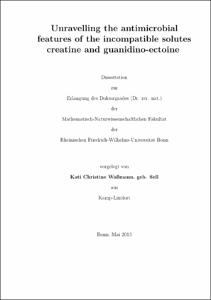Unravelling the antimicrobial features of the incompatible solutes creatine and guanidino-ectoine

Unravelling the antimicrobial features of the incompatible solutes creatine and guanidino-ectoine

| dc.contributor.advisor | Galinski, Erwin A. | |
| dc.contributor.author | Waßmann, Kati Christine | |
| dc.date.accessioned | 2020-04-19T00:16:34Z | |
| dc.date.available | 2020-04-19T00:16:34Z | |
| dc.date.issued | 28.10.2013 | |
| dc.identifier.uri | https://hdl.handle.net/20.500.11811/5763 | |
| dc.description.abstract | Solutes similar in structure to compatible solutes but with an opposite physiological effect on growth rate were named incompatible solutes. Examples of this class of compounds and main objects of investigation in this work are creatine, which resembles the compatible solute glycine betaine, and the synthetic guanidino-ectoine with structural similarities to ectoine. In contrast to compatible solutes, both incompatible solutes contain a guanidino-function which is proposed to be responsible for the growth inhibitory features of these solutes. The major ambition of this work was to reveal why these zwitterionic compounds lead to decelerated growth of gram-negative bacteria in osmotic stress situations Several experiments revealed that incompatible solutes influence ion homoeostasis. In this regard it was shown that creatine but not guanidino-ectoine inhibits the activity of sodium proton antiporters and that both solutes interfere with potassium transport systems, which is, amongst other things, reflected in decreased intracellular trehalose and glutamate concentrations. In the course of metabolome studies, 4-aminobutyrate was observed as a potential compatible solute, which is accumulated in increasing concentrations when medium osmolarity rises and which is absent when (in)compatible solutes are provided in the growth medium. Results of thermal melting curve analysis of DNA, ribosomal melting profiles and gel-shift experiments propose a binding of guanidino-ectoine, and probably also creatine to nucleic acids. According to results of this work it can be concluded that the critical feature, which turns zwitterionic guanidino-compounds into incompatible solutes, is their interference with macromolecules, most notably DNA and ribosomes, and the simultaneous decrease in intracellular concentration of osmotically active metabolites such as trehalose and glutamate. | en |
| dc.language.iso | eng | |
| dc.rights | In Copyright | |
| dc.rights.uri | http://rightsstatements.org/vocab/InC/1.0/ | |
| dc.subject | inkompatible Solute | |
| dc.subject | E. coli | |
| dc.subject | Kreatin | |
| dc.subject | osmotischer Stress | |
| dc.subject | guanidino | |
| dc.subject | incompatible solute | |
| dc.subject | creatine | |
| dc.subject | osmotic stress | |
| dc.subject.ddc | 570 Biowissenschaften, Biologie | |
| dc.title | Unravelling the antimicrobial features of the incompatible solutes creatine and guanidino-ectoine | |
| dc.type | Dissertation oder Habilitation | |
| dc.publisher.name | Universitäts- und Landesbibliothek Bonn | |
| dc.publisher.location | Bonn | |
| dc.rights.accessRights | openAccess | |
| dc.identifier.urn | https://nbn-resolving.org/urn:nbn:de:hbz:5n-33512 | |
| ulbbn.pubtype | Erstveröffentlichung | |
| ulbbn.birthname | Sell | |
| ulbbnediss.affiliation.name | Rheinische Friedrich-Wilhelms-Universität Bonn | |
| ulbbnediss.affiliation.location | Bonn | |
| ulbbnediss.thesis.level | Dissertation | |
| ulbbnediss.dissID | 3351 | |
| ulbbnediss.date.accepted | 19.07.2013 | |
| ulbbnediss.fakultaet | Mathematisch-Naturwissenschaftliche Fakultät | |
| dc.contributor.coReferee | Dahl, Christiane |
Files in this item
This item appears in the following Collection(s)
-
E-Dissertationen (4466)




